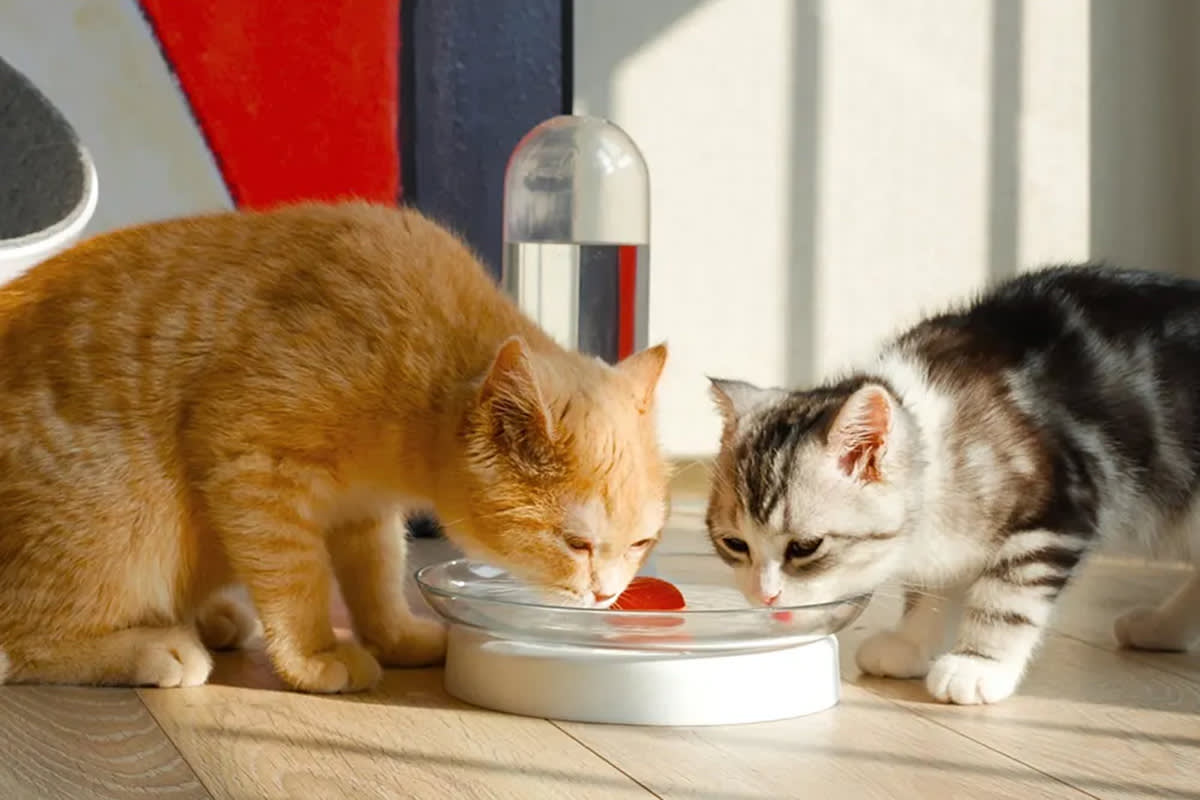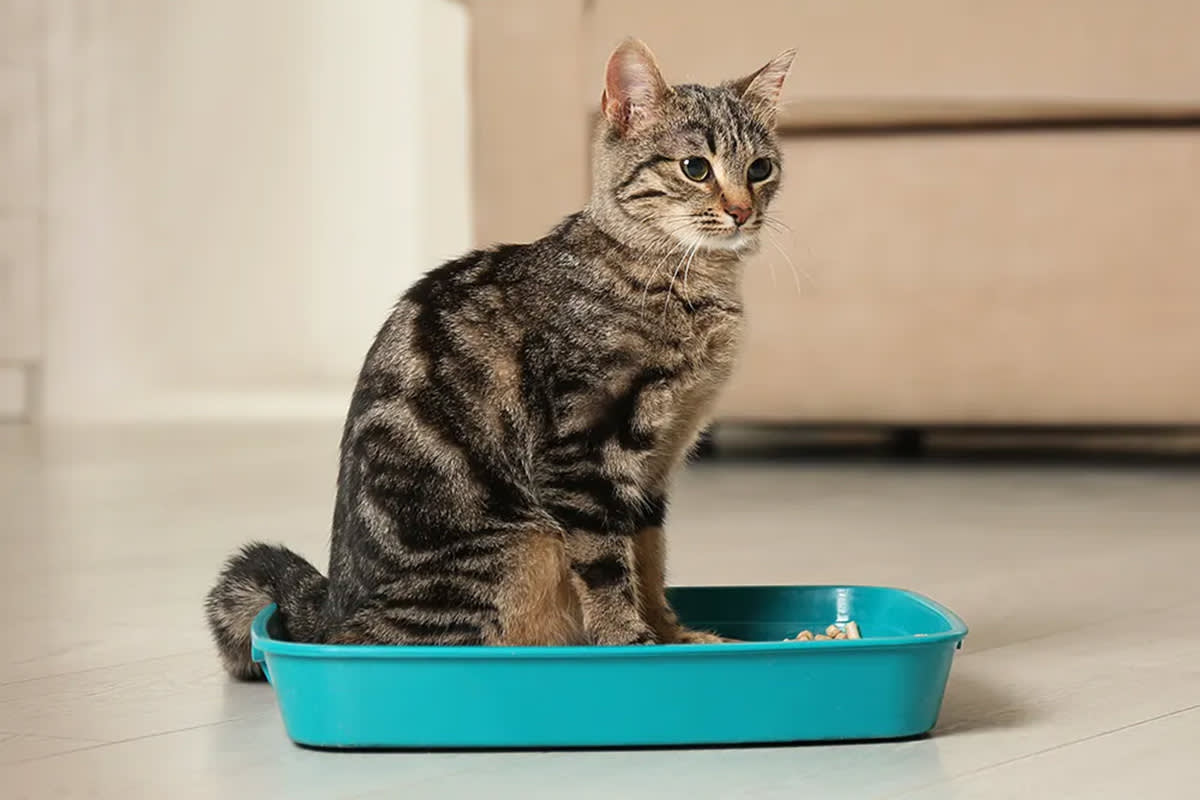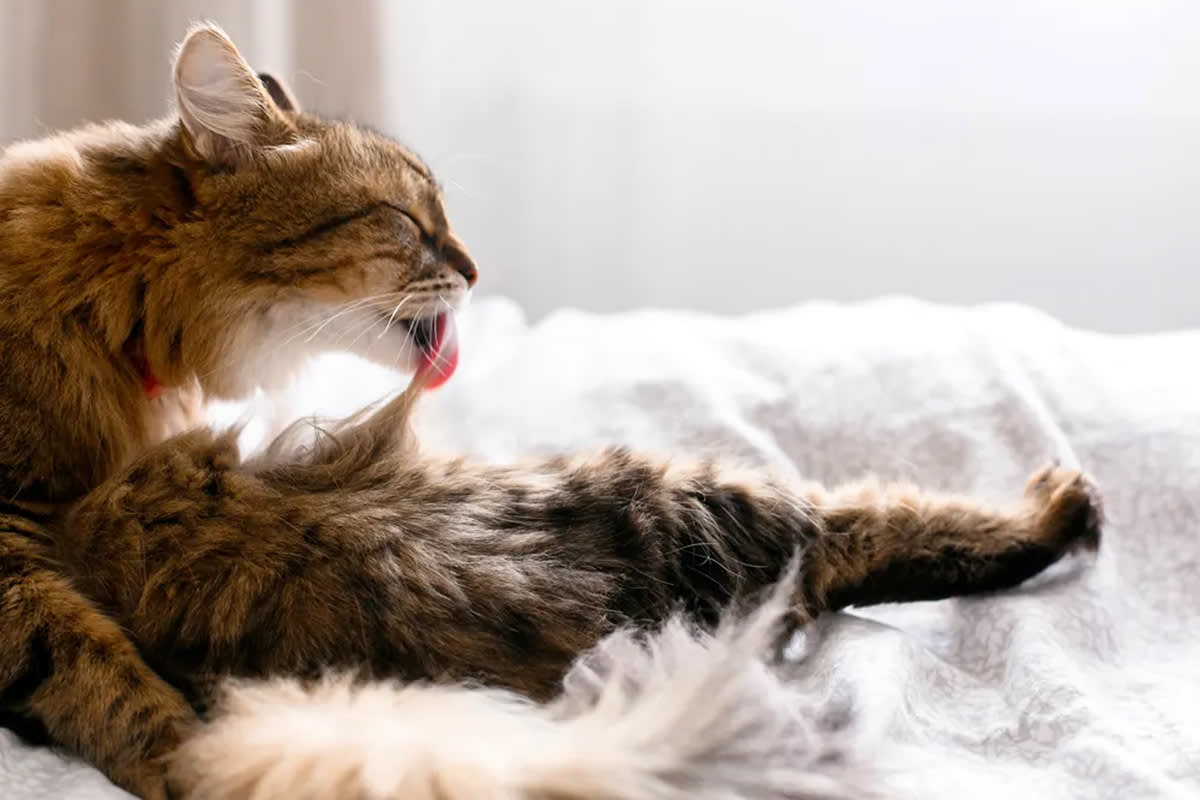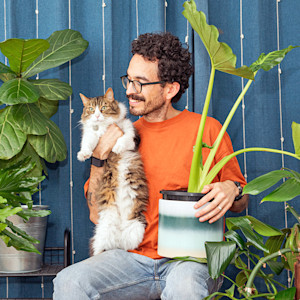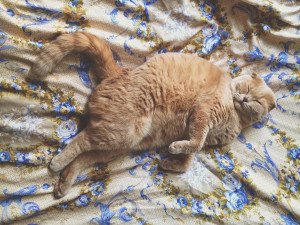9 Ways You Can Tell If Your Cat Is Healthy
Kitties are experts at camouflaging their illnesses; here’s what you need to look for.
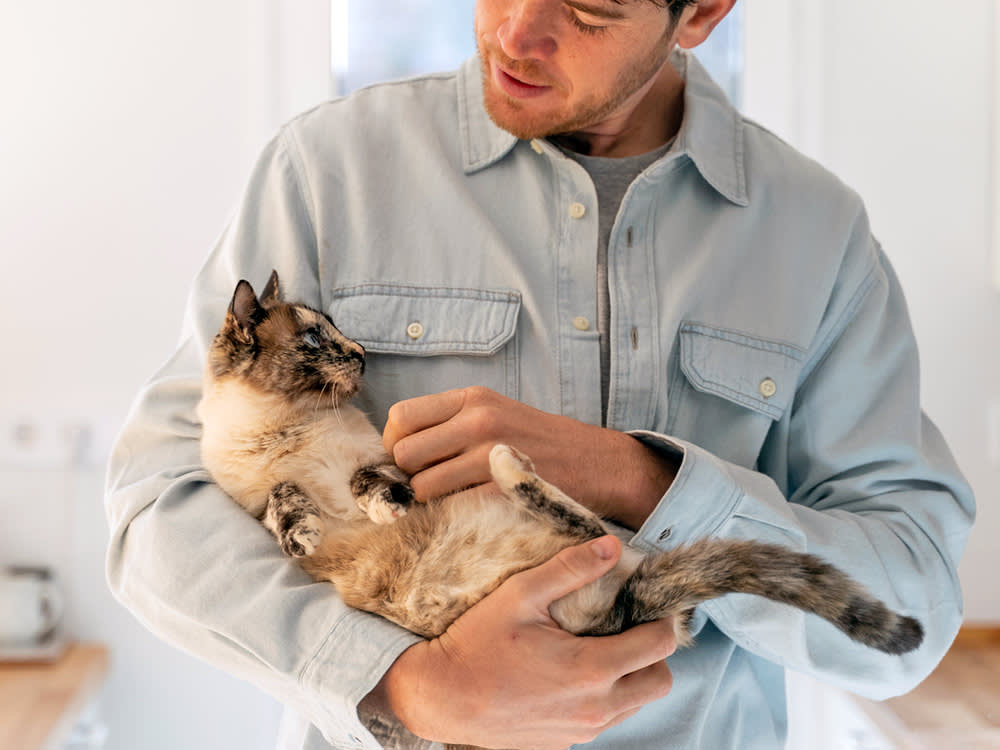
Share Article
One of the most stressful aspects of being a cat parent, perhaps especially for those who are new to the experience, is trying to figure out whether or not they’re healthy. In addition to our interspecies language barrier, cats are notorious for displaying symptoms of illness or injury very subtly — and in some cases, they will even actively try to conceal that they’re not feeling well. Add to the mix that cats are naturally prone to hairballs, picky eating, and vomiting; and it can sometimes feel very difficult to tell if a trip to the vet is warranted or if your cat is just doing normal cat stuff.
Here’s the good news: Becoming a good analyst of your cat’s medical health is actually much simpler than it seems. Once you’re armed with some basic information, all it really requires is that you pay close attention to your cat’s usual habits and routines — and if you love your animals, this is likely something you’re already doing without thinking. Add in a little bit of trusting your gut, and you’ll be able to spot potential illness or injury pretty easily.
But let’s begin with the basics. Here are the main aspects of your cat’s appearance and behavior to pay close attention to.
Watch your cat’s eating habits.
A healthy appetite and regular interest in food is an obvious sign that all is well with your cat. “When a cat is feeling well, she has a good appetite,” says cat behaviorist Rachel Gelleropens in new tab. “She’s eating normally. She’s interested in food, she’s interested in treats.”

It’s also important to take into account what your cat’s relationship to food usually looks like. If a less food-motivated cat is picking at their food one evening, that’s probably not as much cause for concern than if a routine glutton — the cat who comes sprinting into the room as soon as they hear the can opener — is suddenly off their food. “Some cats are picky,” says feline training and behavior specialist Stephen Quandt. “If your cat is always picky, then picky is not a symptom of abnormality.”
And keep an eye on their drinking habits, too.
A healthy cat should also regularly be drinking water. This is a bit trickier to gauge than observing their habits around food. While it’s not necessarily a sign that your cat is sick if they are constantly telling you they’re hungry, a cat who’s drinking excessive or unusual amounts of water is most likely in need of medical attention.
Drinking too much is “common behavior for a medical problem like diabetes or kidney disease,” Quandt says. So, make sure they’re staying hydrated, but pay closer attention if they seem camped out by their water dish.
You’ll also want to look out for their litter box habits.
After all that healthy eating and drinking hopefully comes healthy pooping and peeing. With respect to urination, Quandt advises that pet parents look at frequency, volume, and behavior around the litter box. You need to consider those same factors for their poop habits, but also keep an eye on the consistency of the stool — for example, if it’s unusually loose.
Let’s be real: Scooping your cat’s litter box and looking at their poop most likely isn’t your favorite thing in the world. But their litter box behavior and activity is a crucial metric by which you can judge their health, and behaviorist Jennifer Van de Kieftopens in new tab doesn’t recommend cat parents buy automatic litter boxes for this exact reason. “The litter box is your friend,” Van de Kieft says. “[It] really gives you such good information on your cat's health.” (If you do use an automatic litter box, just make sure you are periodically checking their waste before you throw it out.)
And if your cat is avoiding the litter box altogether? Aside from the obvious problems this presents for you, it also means something’s up with your cat. “When cats are ill, they feel very vulnerable,” Geller says. “They don't want to go into the litter box because that pooping position, or peeing position, puts them in a very vulnerable [spot].”
Observe their sleeping patterns.
Even though cats are notoriously snoozy animals, it is actually possible for a cat to be sleeping an unhealthy amount. If they’re healthy, “there should be periods where your cat is awake,” Van de Kieft says. “Even if they’re not running around, they’re just interested in life — looking out the window, getting up, moving around, playing, even just moving from spot to spot.” Geller also points out that cats will try their best to mirror the routines of their human pals. “Typically, cats will follow our pattern,” she says. “Your cat might be up when you’re up, your cat will sleep when you sleep.” So, if your cat seems to be asleep pretty much every time you look at them, it’s probably worth a phone call to the vet.
As with everything else, there will, of course, be some variation from cat to cat on what constitutes normal behavior. Some cats are sleepier, some are more active, and even a healthy animal may have different energy levels from one day to the next. But you will most likely be able to notice behavior that’s out of character for your cat — and that’s precisely when you need to pay closer attention. Whether it has to do with their sleeping schedule, their amount of sleep, or even their preferred sleeping spots, any significant and sustained shift in habits can be a sign of a problem.
Conversely, sticking to their usual sleep routine is a good sign that they’re healthy and content. “If you see your cat continuing to always be comfortable in their favorite spots — whether it’s a perch by the window or a sun patch on the floor — enjoying her regular favorite resting spots out in the open in your home is a good sign that your cat is feeling OK,” Geller adds.
Make sure they’re grooming regularly.
Eating, drinking, bathroom habits, and sleep routine are all major arenas for keeping an eye on how well your cat is doing. It’s practically second nature to us to observe these patterns of behavior, because it’s also part of how we gauge our own wellbeing. But one thing we don’t necessarily have in common with our kitties is how much time they spend keeping themselves clean.
The behaviorists we spoke to all agree that a healthy cat is a cat who’s well-groomed. “Cats are really fastidious creatures,” Geller. says “Cleanliness is extremely important to cats. So, if you notice your cat's fur is getting more matted, her fur is kind of sticking together … all of those are absolutely a sign that something is wrong.”
Take notice of their vocalizations.
Another more species-specific thing to observe is the range of sounds your cat makes. This can differ wildly between individual cats, so again, it comes down to knowing what’s normal for your specific animal — though a sudden increase in stressed-out sounding meows or yowls will obviously be cause for alarm.
“If your cat is very chatty, then being very chatty is normal,” Quandt says. “If your cat is quiet, and starts vocalizing in ways that are not what you would expect, that could be a sign [that something is not OK].
Purring is also something to look out for. A sick or unhappy cat may not have the energy to purr, even while they’re snuggling with you — but on the flip side, constant purring is also worrisome. “We know that cats can purr as a self-soothing behavior,” Quandt adds. “One of my cats is right next to me right now, and she purrs often when I pet her. But like most cats, she doesn't purr if she's just sitting there, right? If she were to start purring a lot without interaction from me, I might get worried.”
Make sure they are still interested in playtime.
A healthy cat will also display relatively consistent interest in playtime, and a general sense of being engaged with their surroundings. “[A healthy cat] will be enticed by seeing a bird outside the window,” Geller says. “They’ll be enticed by movement.”
“I think all cats should have some level of activity, even senior cats,” Van de Kieft adds. “One of the best things that you can do for your cat to stay physically and emotionally healthy, is to have some exercise and play built in — even if it’s just five minutes a day. [And] if one day your cat doesn’t want to play, or kind of seems off during playtime, that gives you really good information.”
Keep tabs on their weight.
Maintenance of their usual weight is another indicator that your cat is in good health. Obviously, if your chunky cat is currently on a diet, observing a gradual weight loss would not be cause for concern. But all three behaviorists agreed that a sudden, unexplained drop in weight is a major red flag — even if the cat in question was overweight to begin with, Geller says. “Regardless of if your cat has pounds to lose or not, if you see your cat losing weight [that you didn’t plan for], absolutely go to the veterinarian.”
Unfortunately, it can be hard to tell from just looking at our cats whether they’ve been losing weight or not, so Quandt recommends that cat parents purchase a digital baby scale and try to weigh their cats once a week. “Normally, when you weigh your cat, it’s gonna go up and down,” he says. “But if you get three losses in a row, no matter how small those losses are, you have what's called a trend. And a trending loss is probably a medical problem.”
Establish your cat’s baseline.
Simply being a mindful and observant cat parent is by far the most important thing that you can do for your cat’s health, just because it’s so critically important to have a good sense of what their “baseline” is with regard to everything listed above. Each cat is different, but they are all alike in that they’re creatures of habit — so the biggest sign that something’s up is a significant deviation from the norm.
“Cats are very big on routine,” Geller says. “Your cat’s perfect life would be if nothing ever changed. So, if you’re seeing breaks in their routine, if you’re seeing a cat do things that are not usually her predictable behavior, that’s always a sign that something is up.”
Quandt also points out that what counts as abnormal and actionable behavior in your cat may still be within the realm of normal for cats as a species. “You have to know your cat to know what’s normal for them, and to notice when they start deviating from what you’d expect your cat to do — even if it could be considered a subset of normal behavior.”
All this responsibility may feel overwhelming, but if you’re someone who genuinely cares about your pet, it’s likely you’re already paying far more attention to their habits than you realize. Societally, the pet parents of today tend to be far more attentive than those of the past, Van de Kieft adds. “The way today's pet parent views their cat, the cat is a priority. It’s amazing to me how much people really care about their cats, and the level of effort they put in.”
But in case you feel like you don’t have a good enough grip on your cat’s daily routine, it’s an easy enough problem to solve with a little effort. “Whenever you're home, whatever time you have, you should be carving out a little time for your cat,” Van de Kieft advises. “Cats require more enrichment than a lot of us realize. Even if you work outside the home and you have a busy lifestyle, you have a responsibility to pay attention to your cat every day.”
But how do you know if you’re overreacting?
Of course, the flip side to being an attentive and loving cat caretaker is worrying a little bit too much, and making mountains out of molehills. How often a more high-strung type of cat parent i ndulges these concerns will ultimately come down to personal choice.
“Our comfort level and our anxiety play a big factor in how we assess our cat’s health,” Quandt says. “And there's no value judgment here: It's just an appreciation of the different ways people look at this.”
But Van de Kieft thinks it’s generally a good call to listen to your gut. “If something’s telling you ‘this is off,’ I think it's a good idea to listen to that, as opposed to saying ‘Let’s just see what happens.’”
Hopefully, a responsible and well-educated pet parent can also learn to have some confidence in their own judgment. “Some people, if they’re new cat parents, might need to learn what is actionable and what isn't,” Quandt concludes. “Some people may simply be more reactive, and that might mean that some vet visits are technically not necessary … But being responsive to changes and not just dismissing them goes a long way to figuring out if your cat’s OK or not.”

Rachel Pick
Rachel Pick is a freelance writer and social media editor who has written for Vice, The Guardian, and SELF. She lives with two cats: Cricket, a genteel lady who is the picture of refinement, modesty, and good manners; and Cowboy, who is an agent of chaos, slapstick comedy, and foul odors. Her work here frequently focuses on cat companionship and cat behavior.
Related articles
![Man holding cat in lap while surrounded by plants.]()
12 Ways to Tell That Your Cat Is Happy
It’s all in the eyes... and ears and tail. And so much more.
![Red cat with squinted eyes laying in a basket closeup]()
6 Ways Your Cat Could Tell You They Are in Pain
Here are all the way your kitty is trying to tell you they’re hurting.
![Profile view of a man giving a cat food to eat]()
Why Is My Cat Not Eating? Causes, Symptoms, and Treatment
A veterinary nutritionist explains why your cat isn’t eating and how to increase their appetite.
![overweight orange cat]()
How Much Should You Actually Be Feeding Your Cat?
If they’ve lost their hourglass figure, then not that much — according to a veterinary nutritionist.
![Grey cat at looking up from eating on floor at home]()
Gut Feelings: How to Balance Your Pet’s Microbiome
The mind-gut connection isn’t just for people. Your dog or cat’s gut microbiome plays a big role in their health and well-being.

